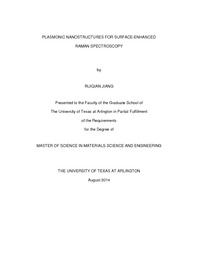
ATTENTION: The works hosted here are being migrated to a new repository that will consolidate resources, improve discoverability, and better show UTA's research impact on the global community. We will update authors as the migration progresses. Please see MavMatrix for more information.
Show simple item record
| dc.contributor.author | Jiang, Ruiqian | en_US |
| dc.date.accessioned | 2014-09-17T17:29:03Z | |
| dc.date.available | 2014-09-17T17:29:03Z | |
| dc.date.issued | 2014-09-17 | |
| dc.date.submitted | January 2014 | en_US |
| dc.identifier.other | DISS-12748 | en_US |
| dc.identifier.uri | http://hdl.handle.net/10106/24713 | |
| dc.description.abstract | In the last three decades, a large number of different plasmonic nanostructures have attracted much attention due to their unique optical properties. Those plasmonic nanostructures include nanoparticles, nanoholes and metal nanovoids. They have been widely utilized in optical devices and sensors.When the plasmonic nanostructures interact with the electromagnetic wave and their surface plasmon frequency match with the light frequency, the electrons in plasmonic nanostructures will resonate with the same oscillation as incident light. In this case, the plasmonic nanostructures can absorb light and enhance the light scattering. Therefore, the plasmonic nanostructures can be used as substrate for surface-enhanced Raman spectroscopy to enhance the Raman signal. Using plasmonic nanostructures can significantly enhance Raman scattering of molecules with very low concentrations.In this thesis, two different plasmonic nanostructures Ag dendrites and Au/Ag core-shell nanoparticles are investigated. Simple methods were used to produce these two plasmonic nanostructures. Then, their applications in surface enhanced Raman scattering have been explored. Ag dendrites were produced by galvanic replacement reaction, which was conducted using Ag nitrate aqueous solution and copper metal. Metal copper layer was deposited at the bottom side of anodic aluminum oxide (AAO) membrane. Silver wires formed inside AAO channels connected Ag nitrate on the top of AAO membrane and copper layer at the bottom side of AAO. Silver dendrites were formed on the top side of AAO. The second plasmonic nanostructure is Au/Ag core-shell nanoparticles. They were fabricated by electroless plating (galvanic replacement) reaction in a silver plating solution. First, electrochemically evolved hydrogen bubbles were used as template through electroless deposition to produce hollow Au nanoparticles. Then, the Au nanoparticles were coated with Cu shells in a Cu plating solution. In the following step, a AgCN based plating solution was used to replace Cu shell to form Au/Ag core-shell nanoparticles. These two plasmonic nanostructures were tested as substrates for Raman spectroscopy. It demonstrated that these plasmonic nanostructures could enhance Raman signal from the molecules on their surface. The results indicate that these plasmonic nanostructures could be utilized in many fields, such as such as biological and environmental sensors. | en_US |
| dc.description.sponsorship | Hao, Yaowu | en_US |
| dc.language.iso | en | en_US |
| dc.publisher | Materials Science & Engineering | en_US |
| dc.title | Plasmonic Nanostructures For Surface-enhanced Raman Spectroscopy | en_US |
| dc.type | M.S. | en_US |
| dc.contributor.committeeChair | Hao, Yaowu | en_US |
| dc.degree.department | Materials Science & Engineering | en_US |
| dc.degree.discipline | Materials Science & Engineering | en_US |
| dc.degree.grantor | University of Texas at Arlington | en_US |
| dc.degree.level | masters | en_US |
| dc.degree.name | M.S. | en_US |
Files in this item
- Name:
- Jiang_uta_2502M_12748.pdf
- Size:
- 2.678Mb
- Format:
- PDF
This item appears in the following Collection(s)
Show simple item record


